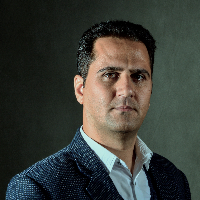A Comparative Analysis of Visual Elements of the Stucco Ornaments in Soltaniyeh Monument, Sayyed Roknaddin Mausoleum and Sayyed Shamsaddin Mausoleum in Yazd
Author(s):
Article Type:
Research/Original Article (دارای رتبه معتبر)
Abstract:
One of the related techniques and ornaments of architecture is the usage of stucco and stucco ornaments, which have had unique features in each historical period before and after Islam. The art of stucco is a technique that could rely on decorations including abstract, geometric and calligraphic designs to leave various masterpieces in various arts, including architecture. In the Ilkhanid period, we see beautifully applied stucco ornaments that were ordered by governors and rulers. One of these buildings is the mausoleum of Sultan Mohammad Khodabandeh (Oljaito) in Soltaniyeh, Zanjan, which due to the importance of that building at that time, various and unique ornaments with different techniques and methods have been implemented in it. The ornaments used in the Soltaniyeh mausoleum include stucco ornaments, Mogharnas work, tile work, inlay work, paintings and inscriptions, and various ornaments. Construction of this monument began at 704 AH and ended after 10 years in 713 AH. Another building is Rokniyeh School in Yazd, which was built in 725 AH. Sayyed Rokn al-Din Mohammad, a judge in Yazd, was a longtime friend of Khajeh Rashid al-Din Fazlullah and the founder of the school. He left many endowed buildings, which are described in the “Jame al-Khayrat” book. The prosperity of Rokniyeh School faded away over time, and since Rokn al-Din himself is buried under the main dome of the school after his death, this building is used as a mausoleum. Shamsieh School in Yazd is the third selected building. Sayyed Shams al-Din was the son of Sayyed Rokn al-Din, who was married to one of the daughters of Khawaja Rashid al-Din Fazlullah. After his father was imprisoned, Sayyed Shams al-Din went to Tabriz and complained to Abu Sa'id. He died in Tabriz in 732 AH and his body was sent to Yazd to be buried under the dome of the Shamsieh School that he had built. This mausoleum is one of the architectural masterpieces of Yazd that Sayyed Sham al-Din designed in Tabriz and sent its plans and designs to Yazd. The reason for choosing these two buildings in Yazd is that these buildings were designed by the artists of the Ilkhanid court, and also the time interval between the construction of these two buildings and the Soltaniyeh mausoleum, which was the most important building of the Ilkhanid period and the capital at that time, is insignificant. Therefore, the stucco ornaments of the Soltaniyeh monument of the Ilkhanid period in Zanjan, as well as the two monuments of the mausoleum of Sayyed Rokan al-Din and the tomb of Sayyed Shams al-Din of the Al-Muzaffar period in Yazd, are exemplary and exquisite historical examples of the use of stucco ornaments in architecture. Furthermore, allowing this art to remain unknown and failing to study it, will cause it to be forgotten and destroyed over time. The objectives of the present study are to identify, analyze and structurally adapt the visual elements used in stucco ornaments and the influencing factors in these buildings, and to study their influence from each other in order to recognize them both to recreate the patterns as well as to recognize the differences in style. In terms of the design and execution of stucco ornaments; since the lack of sufficient knowledge of the interactions of the Ilkhanid era buildings has caused a gap in the classification of stucco ornaments of the Ilkhanid period, the present study will help to fill the gap in the typology of stucco ornaments of this period and to reveal the points covered by Ilkhanid art. This research is organized around three main questions: 1- What are the visual elements of the stucco ornaments in Soltaniyeh mausoleum and the two mausoleums of Sayyed Roknaddin Mohammad and Sayyed Shamsaddin and what are their characteristics? 2. What are the commonalities and differences in the three buildings? 3- What are the possible interaction effects in these three buildings? The research method is descriptive-analytical and "comparative-relative", and the method of collecting information is fieldwork and library studies. The results of the studies showed that the visual elements of the stucco ornaments of the mentioned buildings are classified into three categories: plant motifs, geometric motifs and calligraphy. Characteristics of visual elements of stucco ornaments of the two Muzaffarid buildings in Yazd are affected by the Soltaniyeh mausoleum, and the variety of stucco inscriptions of Soltaniyeh mausoleum is more than two selected buildings in Yazd. Furthermore, in all three buildings, Islamic motifs, geometric knots, Thuluth and Kufic scripts have been observed.
Keywords:
Language:
Persian
Published:
Negareh journal, Volume:17 Issue: 62, 2022
Pages:
149 to 171
magiran.com/p2492397
دانلود و مطالعه متن این مقاله با یکی از روشهای زیر امکان پذیر است:
اشتراک شخصی
با عضویت و پرداخت آنلاین حق اشتراک یکساله به مبلغ 1,390,000ريال میتوانید 70 عنوان مطلب دانلود کنید!
اشتراک سازمانی
به کتابخانه دانشگاه یا محل کار خود پیشنهاد کنید تا اشتراک سازمانی این پایگاه را برای دسترسی نامحدود همه کاربران به متن مطالب تهیه نمایند!
توجه!
- حق عضویت دریافتی صرف حمایت از نشریات عضو و نگهداری، تکمیل و توسعه مگیران میشود.
- پرداخت حق اشتراک و دانلود مقالات اجازه بازنشر آن در سایر رسانههای چاپی و دیجیتال را به کاربر نمیدهد.
In order to view content subscription is required
Personal subscription
Subscribe magiran.com for 70 € euros via PayPal and download 70 articles during a year.
Organization subscription
Please contact us to subscribe your university or library for unlimited access!



